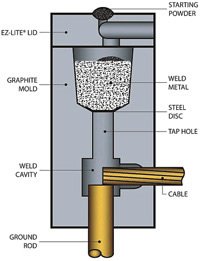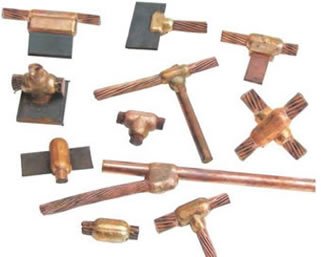

What is Exothermic Welding?
There are many advantages of using Exothermic Welding powder. The most important one being that the process produces a molecular joint and not just a mechanical one in between the conductors. It is produced through a starting reactant which provides enough energy to activate the welding reaction. This takes place quickly and safely inside a graphite mould.
The mould is designed specifically for a certain union depending on the elements to be welded and the joint type required. We guarantees all types of joints, not only copper cable unions but also to weld tapes, brass metallic pieces, stainless steel, steel ground rods covered with copper, etc. It is especially useful for joining dissimilar metals.
When Exothermic Welding is used?
Exothermic welding is most commonly used for permanently joining copper conductors. It is the only acceptable means of bonding copper to galvanized cable. It can also be used on stainless steel, cast iron, steel, brass, bronze, and more. If joining two dissimilar metals, exothermic welding is a good option. You’ll find Exothermic welding under the names of Such as AIWELD®
Features of using Exothermic Welding for Connection Joint:
- It has a superior electrical conductivity than the conductors themselves.
- It does not corrode oxide or degrade with time and is resistant to galvanic coupling.
- It is able to withstand repeated electrical discharges.
- It never increases its resistance.
- It has higher mechanical and squeezing resistance than the conductors themselves.
- It offers a permanent welding and a low resistance connection, essential for achieving longwearing and trustworthy results in earthings
- It guarantees the most common connections not only between copper cables but also for welding tapes and metallic pieces made of brass, stainless steel, and copper coated steel earth rods.
Exothermic Welding powder is a welding process for joining two electrical conductors that employs super heated copper alloy to permanently join the conductors. The process employs an exothermic reaction of a copper Thermite composition to heat the copper, and requires no external source of heat or current. The chemical reaction that produces the heat is an alumina Thermit reaction between aluminium powder and a metal oxide.
The reaction reaches very high temperatures, depending on the metal oxide used. The reactants are usually supplied in the form of powders, with the reaction triggered using a spark from a flint lighter. The activation energy for this reaction is very high however, and initiation requires either the use of a “booster” material such as powdered magnesium metal or a very hot flame source. The aluminium oxide slag that it produces is discarded.
When welding copper conductors, the process employs a semi-permanent graphite crucible mould, in which the molten copper, produced by the reaction, flows through the mould and over and around the conductors to be welded, forming an electrically conductive weld between them. When the copper cools, the mould is either broken off or left in place. Alternatively, hand-held graphite crucibles can be used. The advantages of these crucibles include portability, lower cost (because they can be reused), and flexibility, especially in field applications.
The weld formed has higher mechanical strength than other forms of weld, and excellent corrosion resistance. It is also highly stable when subject to repeated short-circuit pulses, and does not suffer from increased electrical resistance over the lifetime of the installation. However, the process is costly relative to other welding processes, requires a supply of replaceable moulds, suffers from a lack of repeatability, and can be impeded by wet conditions or bad weather (when performed outdoors).
How Exothermic Welding Works?
The Exothermic Welding System is a welding process that utilizes an exothermic reaction (a chemical reaction that releases energy in the form of very high temperatures and light) to permanently join metal connections. Exothermic Welding uses a light-weight, clamp-on graphite mold to safely position and contains any weld required. The exothermic reaction creates an intense miniature furnace with temperatures exceeding 2,500 °F, instantly producing molten metal which flows into the weld cavity, filling any available space. After waiting adequate time after the initial process, the mold can be released and the finished connection removed.
Why Use Exothermic Welding?
The Exothermic Connecting created a permanent, homogeneous, and molecular bond that cannot loosen or corrode, and will carry more current that the conductor.The Exothermic Welding Connection are solid molecular bonds, they do not loosen or corrode over the lifetime of connection. The ame cannot be said about other methods; such as brazing, crimp, split bolt, or compression type connections.
Overview:
In Exothermic Welding powder, aluminium dust reduces the oxide of another metal, most commonly iron oxide, because aluminium is highly reactive. Iron(III) oxide is commonly used:
Fe2O3 + 2 Al → 2 Fe + Al2O3
The products are aluminium oxide, free elemental iron, and a large amount of heat. The reactants are commonly powdered and mixed with a binder to keep the material solid and prevent separation. Commonly the reacting composition is 5 parts iron oxide red (rust) powder and 3 parts aluminium powder by weight, ignited at high temperatures. A strongly exothermic (heat-generating) reaction occurs that via reduction and oxidation produces a white hot mass of molten iron and a slag of refractory aluminium oxide. The molten iron is the actual welding material; the aluminium oxide is much less dense than the liquid iron and so floats to the top of the reaction, so the set-up for welding must take into account that the actual molten metal is at the bottom of the crucible and covered by floating slag.
Other metal oxides can be used, such as chromium oxide, to generate the given metal in its elemental form. Copper thermite, using copper oxide, is used for creating electric joints in a process called Cad welding:
3 CuO + 2 Al → 3 Cu + Al2O3
TOOLS REQUIRED FOR EXOTHERMIC WELDING PROCESS
1) Graphite Mould
2) Mould Handle Clamp (Universal)
3) Steel Metal Disk
4) Exothermic Weld Powder
5) Ignite Powder (Starting Powder)
6) Gloves
7) Flint Gun
8) Brush (Soft and Hard)
9) Slag Removal Tool
10) File Card
11) Sealing Compound
12) Flame Torch
For more details, Please visit this link Exothermic Weld Accessories
Download our Free Pdf Catalogue here:
![]() What is Thermite Welding – Amiable impex®
What is Thermite Welding – Amiable impex®
![]() What is Thermit Welding – AIWELD®
What is Thermit Welding – AIWELD®
Amiable Impex is the only Company in India that offer Quality of Exothermic Welding Powder and Exothermic Welding Accessories at reasonable rate and ensures delivery within 10 to 15 days in India. Get high quality of Our products at quickest lead time with fast response time. Full Customer Satisfaction. Our Products are tested and approved by CPRI Govt Body, Its also CE and ROHS Certified and we are also certified by ISO 9001:2008, Crisil verified Company.
For any questions or quote please feel free to contact us at [email protected] or Call us at +91-22-28933996 / +91-9594899995